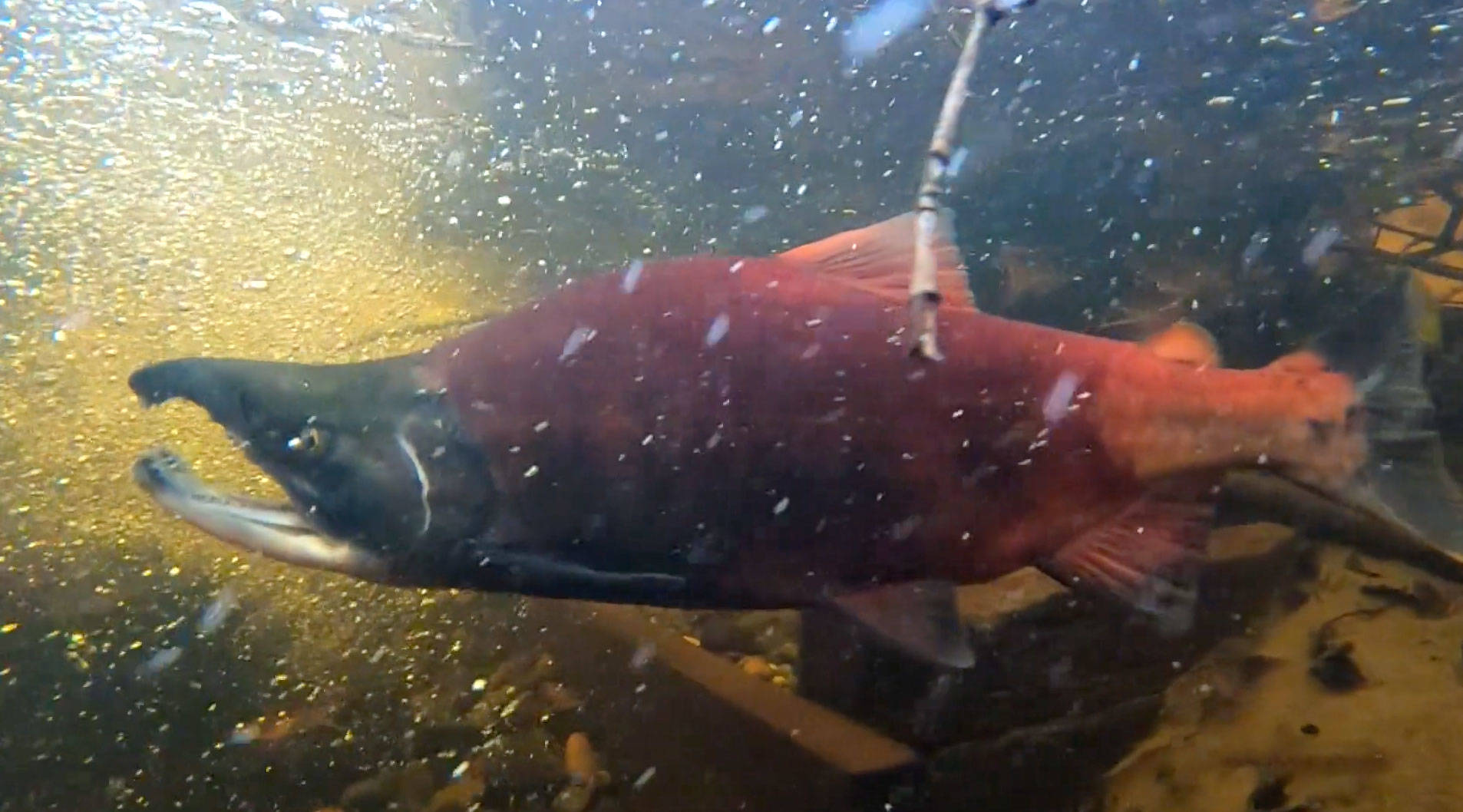It was 10 p.m. when filmmaker Nils Cowan got the telephone call.
The next morning, there would be an egg release for the embattled kokanee salmon near Issaquah. For the past couple of years, Cowan had been working on a film about the little red fish. They’re a freshwater variety of salmon that live in Lake Sammamish and surrounding bodies of water. So the next morning he scrounged up a camera and made the trek from his Seattle home to a private slice of stream for the release in early January 2019.
“It was a foggy day that sort of — the sun came glinting through — there was tribal membership, the mayor of Sammamish, basically everyone who was in the film showed up,” Cowan said.
Those gathered began releasing kokanee eggs by hand into incubator boxes that protected the eggs from predators. A prayer circle formed, and one of the men whom Cowan said was from the Yakama Nation began singing a warrior song, followed by a few minutes of silence.
“These last kind of fragile eggs — basically the future of the population — and this blessing that just happened, and I kind of just felt because of this human commitment, these fish are probably going to be able to bounce back,” Cowan said. “There’s just this moment of intense calm and blessing, and just a really powerful quiet moment.”
Those kokanee salmon need all the help they can get. The number of the fish that have returned to spawn in recent years has dwindled from the thousands to just 19 in 2018. Last year, only about 100 came back, well below a healthy and sustainable level.
The low numbers have prompted a sweeping response from local and state agencies, conservation groups and area tribes. And for the past three years, Cowan has been working on a documentary tracing those efforts. Now, the 50-minute film called “Spawning Grounds” is finally ready for its debut Jan. 18 in North Bend.
Cowan said he became interested in making the film because it told the stories of the fish and the indigenous peoples for whom the fish has been an integral part of their culture since time immemorial. That relationship is featured heavily in the film.
“Unfortunately, myself included, [there’s] just not a lot of time on people’s schedules to learn about that culture and the true history of this region,” he said.
A representative of the Snoqualmie Tribe declined to comment for this story because of the recent deaths of two elders. However, tribal leaders told KUOW in 2018 that the Snoqualmie used to trap kokanee and had relied on them as a staple food. The fish worked well stored and dried, and they kept over the winter.
When Cowan started making the documentary, the returning Lake Sammamish kokanee numbered in the thousands, but halfway through they began dwindling. Researchers have hypothesized that high temperatures in the lake during the summers of 2014 through 2016 had driven the fish deeper underwater. But at greater depths, there’s less oxygen, so many kokanee are thought to have suffocated.
“Everyone redoubled their efforts. It was just this amazing all hands on deck scenario that was really inspirational to cover,” Cowan said.
David St. John, a policy advisor with the King County Department of Parks and Natural Resources, is one of those people. He was involved with efforts last year to fly kokanee to Orcas Island, where 250 of them will be raised in captivity. It’s an extreme measure, but one that could preserve the fish’s lineage.
St. John said he’s excited to see the final version of the film.
“We knew he was a good storyteller, and his work proves that he did a great job of getting to know the people and the subject matter, and telling what I think is a pretty nuanced and accurate story from his own perspective,” St. John said.
Trout Unlimited is another organization that has been involved with kokanee restoration since 2005, said Mark Taylor with the Washington chapter. Taylor is a lifelong resident of the area, and can remember driving around Lake Sammamish when it wasn’t surrounded by “$7 billion mansions.”
“I’m seeing places and the fish that I’ve enjoyed my whole life disappear, and it’s really accelerated in the last 10 years,” Taylor said. “Things are never going to go back to the way they were, but we can stop the bleeding, and kind of get things stable so we can reconcile what we’ve done to the environment.”
Taylor said one of the takeaways from the restoration projects is cooperation. Tribes, local and federal governments and volunteer groups all came together to try and save the little red fish. He hopes the film will inspire more people to get involved.
For Cowan, the ultimate goal for the film is similar, and he hopes it will find its way into classrooms and on PBS. After it premieres, he’ll start shopping it around to film festivals.
“It’s definitely a story that’s close to my heart now,” he said.
The film will debut at 6 p.m. Jan. 18 at the North Bend Theater, 125 Bendigo Blvd. N., and includes a panel discussion afterward. A similar event will be held at the University of Washington’s Intellectual House beginning at 3:30 p.m. Feb. 8.


